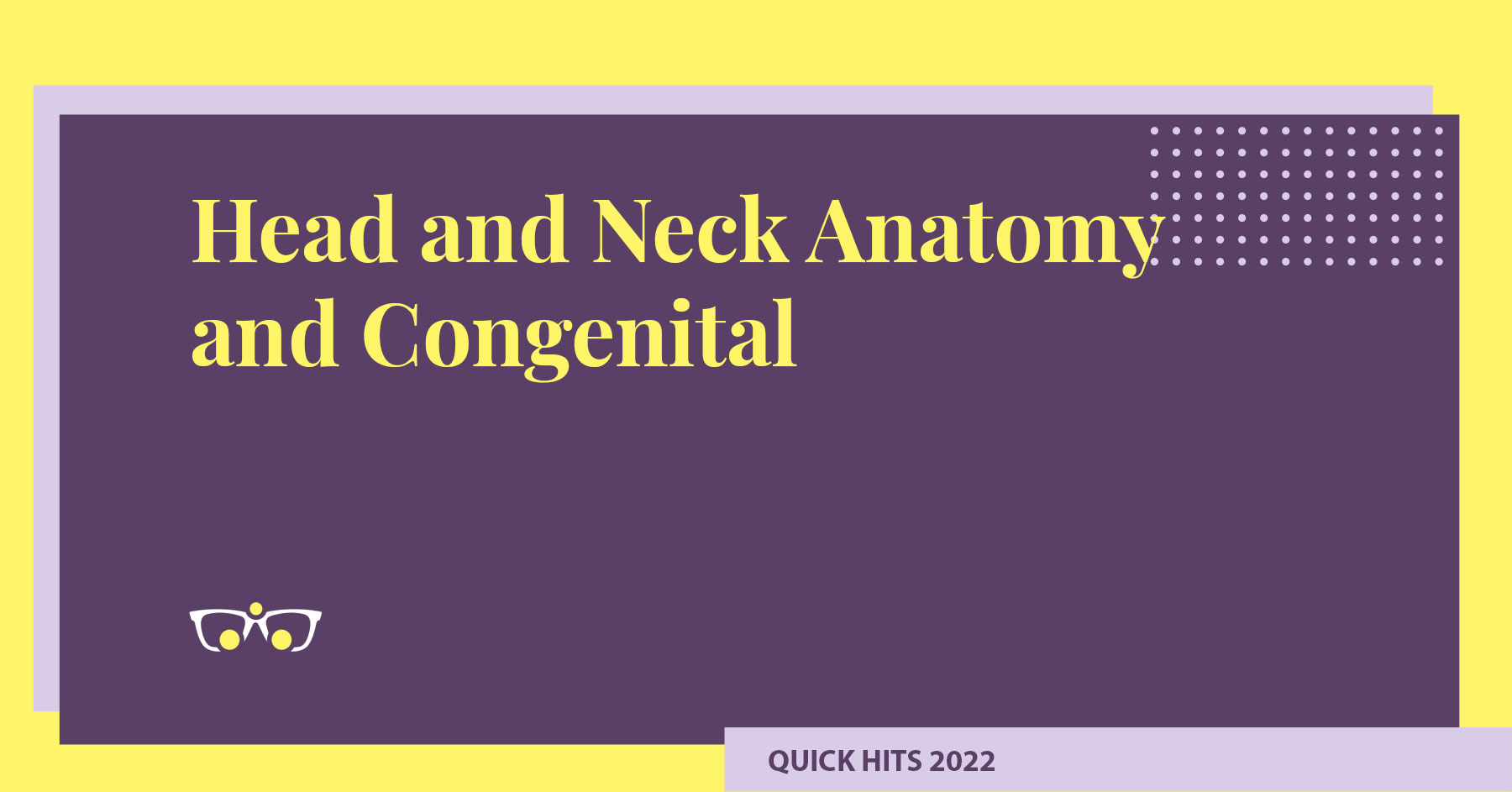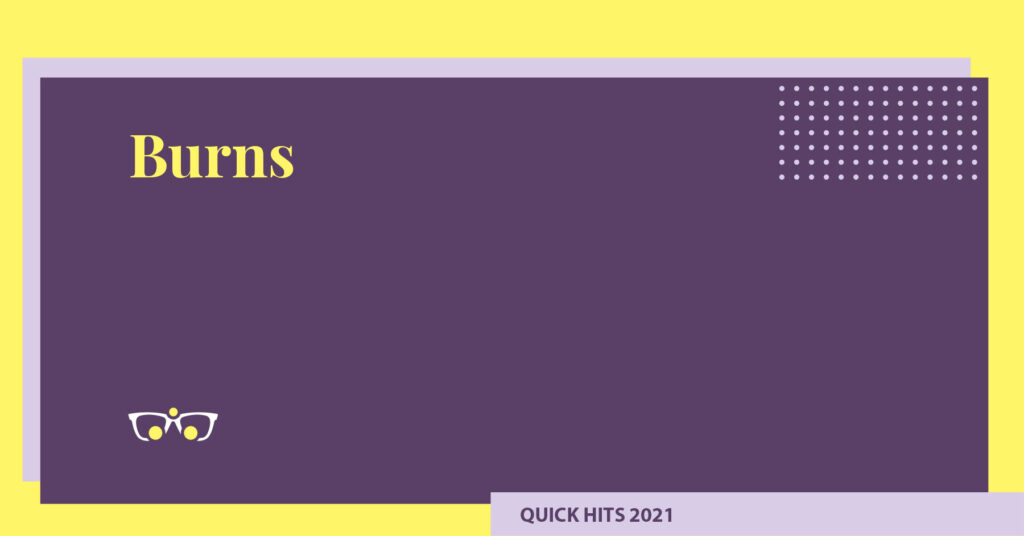Head and Neck Anatomy and Congenital
- Branchial arches
- first arch (CNV)– mandible, maxilla, zygoma, malleus, incus, muscles of mastication, tensor palatini and tympani, mylohyoid, anterior digastric, tragus, root of helix, superior helix.
- pouch forms EAC and middle ear.
- second arch (CNVII) – stapes, styloid, lesser horn of hyoid bone, muscles of facial expression, stapedius, stylohyoid, posterior digastric, antihelix, antitragus, lobule.
- pouch forms tonsillar fossa.
- third arch (CNIX) – lower neck glands – greater horn of hyoid, stylopharyngeus, common carotid, internal carotid.
- pouch forms inferior parathyroids and thymus.
- fourth arch (CNX) – upper neck – larynx, laryngeal and pharyngeal muscles, soft palate (including levator veli palatini), aortic arch, right proximal subclavian artery, superior laryngeal nerve.
- pouch forms superior parathyroid and parts of the thyroid.
- sixth arch (CNXI) – lateral/posterior neck – SCM + trapezius, aorta, ductus arteriosus, pulmonary artery
- Branchial clefts:
- First branchial cleft: develops into the external auditory canal
- Second, third and fourth branchial clefts merge to form the sinus of His
- A branchial cleft cyst forms when a cleft is not properly involuted
- A fistula forms when branchial pouch and cleft fail to become involuted
- Branchial cleft cysts divided into type I and II: I near EAC (inferior and posterior to tragus, but can also be in parotid gland)
- II near angle of mandible and may involve submandibular gland
- Second branchial cleft accounts for 95% of branchial anomalies, most commonly identified along the anterior border of upper third of SCM and adjacent to muscle)
- Congenital Abnormalities
- Thyroglossal duct cyst: midline, moves when patient swallows– foramen cecum originates between first and second pouches opening of thyroglossal duct –> carries thyroid to final position 7 weeks –> the thyroid descends during development from base of tongue into the neck. if the tract doesn’t involute, congenital thyroglossal duct can remain. can present as cyst at hyoid bone or up to base of tongue –> when resecting should resect central part of hyoid bone (Sistrunk procedure)
- torticollis – congenital neck deformity involving shortening of the SCM. symptoms are head tilt and limited ROM, with palpable mass on affected SCM. usually resolves on its own but some may become fibrotic –> treat with surgical release
- Torticollis: On physical examination, findings include flexion of the head and neck toward the ipsilateral shoulder, rotation of the head and neck to the contralateral shoulder, and a lack of lateral flexion toward the contralateral shoulder.
- Choanal atresia: if b/l patient may have paradoxical cyanosis (cyanosis relieved by crying), associated with CHARGE, can be diagnosed with CT scan showing enlarged vomer, medially displaced lateral nasal wall and pterygoid plates
- Lingual thyroid: failure of thyroid to descend- can present as posterior tongue mass with airway obstruction
- Subglottic stenosis: membranous or cartilaginous (cricoid cartilage), can present as airway obstruction
- Dermoid cysts: present as mobile well circumscribed masses near lateral brow –> treated with excision
- midline masses require imaging in case of intracranial extension
- Gorlin syndrome: BCC, bifid ribs, scoliosis, keratocystic odontogenic tumors of the mandible
- Keratocystic odontogenic tumors include keratinized epithelium without characteristic epidermal architecture, such as rete ridges
- Ameloblastoma: palisading basaloid cells
- Congenital epulis- rare, benign tumor of the oral cavity found in newborns, they are a form of granular cell tumor, treated with excision
- Anatomy
- Stylomastoid foramen contains facial nerve
- Foramen lacerum: ICA
- Foramen rotundum: V2; foramen ovale: V3
- Jugular foramen: CN IX,X,XI
- Zones of neck:
- I: inferior neck: from clavicles to cricoid proximal carotid and vertebrals, apices of lung, trachea, esophagus, spinal cord, thoracic duct
- II: mid neck: cricoid cartilage to angle of mandible- jugular veins, vertebral and common carotid, internal and external
- III: above angle of mandible to base of skull base- pharynx, jugular veins, vertebral arteries, distal portions of IC
- Lacrimal duct exits via the valve of Hasner, below the inferior turbinate
Innervation
- Trigeminal nerve (mastication muscles and facial sensation)
- V1 ophthalmic – supplies sensation to the forehead via the supraorbital and supratrochlear nerves. these emerge from the frontal bone at the superior orbital rim above the mid-pupil
- V2 maxillary – supplies sensation to the midface and maxillary dentition. branches include the zygomaticotemporal, zygomaticofacial, and infraorbital. the infraorbital emerges from the bone about 1cm below the inferior orbital rim below the mid-pupil
- V3 mandibular – supplies sensation to the superior ear, and lower face including mandible via the buccal, lingual, inferior alveolar, and mental nerves. auriculotemporal branch is easily injured posterior to the mandibular condyle where it runs along with superficial temporal artery; mental nerve is at risk where it exits the buccal surface of the mandible below second premolar/bicuspid
- Lingual nerve: branch of V3 and supplies anterior 2/3 tongue
- Spinal Accessory Nerve – innervates the SCM and trapezius and is at risk as it leaves the posterior border of the SCM above the deep cervical fascia 6cm below the angle of the mandible
- Accessory nerve runs with occipital artery
- Auriculotemporal nerve: branch of trigeminal, most likely to be injured in microvascular decompression of trigeminal neuralgia
- Auriculotemporal carries parasympathetic fibers to parotid gland in healthy patient
- Superior oblique muscle innervated by CN IV, lateral rectus by CN VI, the rest by oculomotor (CN III)
Vascular
External carotid artery (some angry lady figured out PMS)
- Superior thyroid artery
- Ascending pharyngeal
- Lingual artery
- Facial artery – crosses onto the anterior surface of the mandible 3cm anterior to the mandibular angle, near hypoglossal nerve
- branches include: ascending palatine, premasseteric, lateral nasal, submental, superior labial, inferior labial, tonsillar
- Occipital artery
- Posterior auricular
- Maxillary
- branches to bony portion (meninges, inferior alveolar), muscular portion (masseter, buccinator, pteyrgoids, temporal), and pterygomaxillary portion (palatine arteries, infraorbital artery, superior alveolar arteries)
- Superficial temporal
- frontal (anterior temporal)
- parietal (posterior temporal)
Glands and palate
- salivary glands
- parotid – innervated by parasympathetic auriculotemporal nerve (CNV), but CNVII passes through
- submandibular glands produce the most saliva > parotid > sublingual
- Submandibular gland is responsible for basilar salivary production
- Resection of submandibular gland indicated for recurrent sialadenitis or obstructive sialodocholithiasis or pleomorphic adenomas
- Parotid gland receives parasympathetic innervation from glossopharyngeal nerve, IX also receives taste from posterior 1/3 of tongue
- Chorda tympani (from facial nerve via LINGUAL NERVE) supplies submandibular/sublingual glands and taste to anterior 2/3 tongue
- Stenson’s duct: in the buccal space (bordered by orbicularis muscle, edge of masseter, superiorly by zygomaticus major, and inferiorly by fascial attachment of buccinator), enters oral cavity opposite upper second molar
- Middle third line between tragus and middle upper lip defines course of parotid duct (buccal branch and zygomatic branch also lie in close proximity)–> can result in sialocele and fistula
- Suppurative sialadenitis: treate with abx and sialogogues with warm soaks and fluid replacement
- Frey syndrome – injury to the parotid gland (and mixing of CNV auriculotemporal parasympathetic with surrounding peripheral sympathetic sweat glands) causes gustatory sweating
- Innervation to hard palate: anterior hard palate is sphenopalantine and nasopalantine; posterior is greater palatine; soft palate is lesser palantine
- Dentition and Orthognathic
- Periodontal ligament anchors tooth in socket
- Lingual nerve at risk for injury during third molar extractions given its proximity to the lingual border of the mandible
- Hyperdontia usually occurs in the maxilla, more common in males and more common in permanent dentition
- Ectodermal dysplasia associated with HYPOdontia
- Benign masseteric hypertrophy: associated with repetitive clenching of teeth, for mild hypertrophy can use botox, anxiolytics, surgical resection used for cosmesis
- Inject 30-50U within the body of the masseter
- u/l condylar hyperplasia: overgrowth of mandibular condyle –> can present with u/l facial enlargement, deviation of mandibular midpoint to unaffected side, class III maloclusion, crossbite –> treat with condylar resection
- Myxoma: slow growing benign tumor; commonly in mandible or maxilla when occurs in the face, slow growing and should be resected with clear margins
- OSA
- Most common site of obstruction is the uvula and lateral pharyngeal walls in patients with OSA
- Most common corrective surgery of OSA: uvulopalatopharyngoplasty (UP3)- removing uvula and lateral oropharyngeal tissues; most common site is retropalatal area, including lateral pharyngeal walls
- tracheostomy is curative but has high morbidity
- CPAP and tonsillectomy for mild disease







